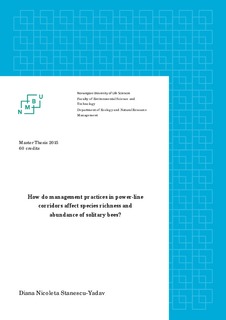How do management practices in power-line corridors affect species richness and abundance of solitary bees?
Master thesis
Permanent lenke
http://hdl.handle.net/11250/294068Utgivelsesdato
2015-07-31Metadata
Vis full innførselSamlinger
- Master's theses (INA) [593]
Sammendrag
In order to identify opportunities for biodiversity conservation, it is important to understand how current land use patterns threaten the integrity of ecosystems and the services they provide. The aim with this study was to test how the experimental manipulation of the habitat conditions under power-line corridors affects species richness and abundance of solitary bees.
Nineteen sites situated under the power-line strips transecting boreal forests in south-eastern Norway were selected. In each one of them were placed three experimental units: one cleared and the debris removed from the experimental unit (removal), another one cleared following standard management practice where the debris is left on the ground (standard) and last left uncleared acting as a control. Three flight interception traps were placed in each experimental unit.
A total number of 613 individuals and 63 species of solitary bees were collected.
Clearing of power-lines corridors led to an increase in diversity of solitary bees in both cleared experimental units, but the highest species richness and abundance of solitary bees was observed in the management areas cleared of woody debris. In almost half of sites there was a higher solitary bees’ species richness in removal experimental unit than other two experimental units. A positive response of solitary bee species richness to total forbs’ species richness was observed in same type of experimental unit.
The results of this experiment suggest that clearing of forest in the power-line corridors may create new habitats that enhance the diversity of solitary bees.
